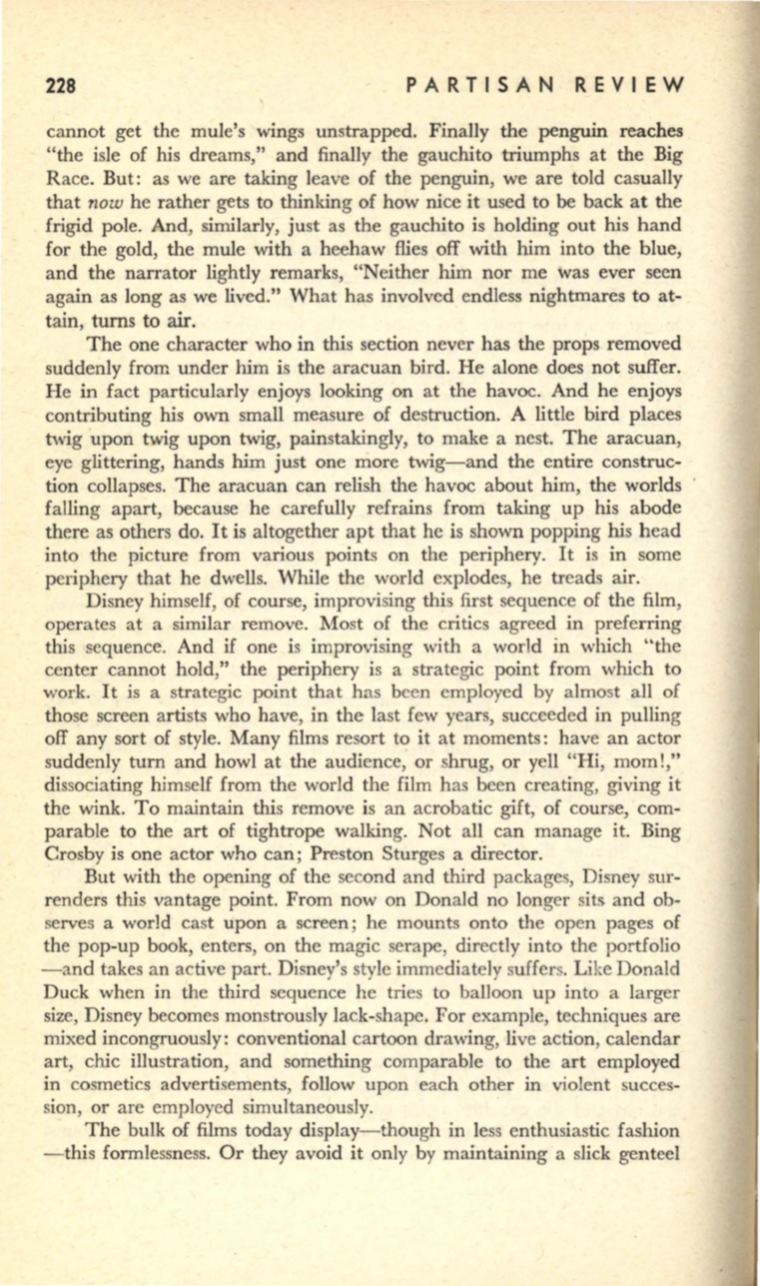
228
PARTISAN REVIEW
cannot get the mule's wings unstrapped. Finally the penguin reaches
"the isle of his dreams," and finally the gauchito triumphs at the Big
Race. But: as we are taking leave of the penguin, we are told casually
that
now
he rather gets to thinking of how nice it used to be back at the
frigid pole. And, similarly, just as the gauchito is holding out his hand
for the gold, the mule with a heehaw flies off with him into the blue,
and the narrator lightly remarks, "Neither him nor me was ever seen
again as long as we lived." What has involved endless nightmares to at–
tain, turns to
air.
The one character who in this section never has the props removed
suddenly from under him is the aracuan bird. He alone does not suffer.
He in fact particularly enjoys looking on at the havoc. And he enjoys
contributing his own small measure of destruction. A little bird places
twig upon twig upon twig, painstakingly, to make a nest. The aracuan,
eye glittering, hands him just one more twig-and the entire construc–
tion collapses. The aracuan can relish the havoc about him, the worlds
falling apart, because he carefully refrains from taking up his abode
there as others do. It is altogether apt that he is shown popping his head
into the picture from various points on the periphery. It is in some
periphery that he dwells. While the world explodes, he treads air.
Disney himself, of course, improvising this first sequence of the film,
operates at a similar remove. Most of the critics agreed in preferring
this sequence. And if one is improvising with a world in which "the
center cannot hold," the periphery is a strategic point from which to
work. It is a strategic point that has been employed by almost all of
those screen artists who have, in the last few years, succeeded in pulling
off any sort of style. Many films resort to it at moments: have an actor
suddenly turn and howl at the audience, or shrug, or yell "Hi, mom!,"
dissociating himself from the world the film has been creating, giving it
the wink. To maintain this remove is an acrobatic gift, of course, com–
parable to the art of tightrope walking. Not all can manage it. Bing
Crosby is one actor who can; Preston Sturges a director.
But with the opening of the second and third packages, Disney sur–
renders this vantage point. From now on Donald no longer sits and ob–
serves a world cast upon a screen; he mounts onto the open pages of
the pop-up book, enters, on the magic serape, directly into the portfolio
-and takes an active part. Disney's style immediately suffers . Like Donald
Duck when in the third sequence he tries to balloon up into a larger
size, Disney becomes monstrously lack-shape. For example, techniques are
mixed incongruously: conventional cartoon drawing, live action, calendar
art, chic illustration, and something comparable to the art employed
in cosmetics advertisements, follow upon each other in violent succes–
sion, or are employed simultaneously.
The bulk of films today display-though in less enthusiastic fashion
-this formlessness. Or they avoid it only by maintaining a slick genteel


